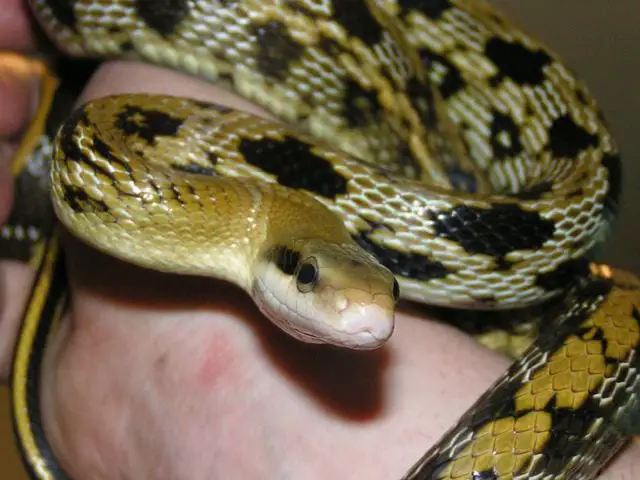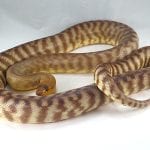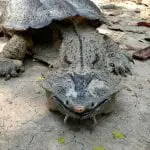Scientific Facts
| Common Name | Taiwan Beauty Snake |
| Scientific Name | Elaphe taeniura friesei |
| Range | Southeastern regions of Asia such as Thailand, Vietnam, Burma, China, and Taiwan |
| Habitat | Vegetation to rocky areas or forests as long as there are near bodies of water |
| Diet | Rodents such as rats, mice, different eggs in burrows, and birds. |
| Size and Weight | Males: 4–6 feet (1.2–1.8 m)Females: 9.2 feet (2.8 meters) |
| Lifespan | Wild: 12-15 yearsCaptivity: 20-25 years |
Physical Description
The Taiwan Beauty Snake is a rat snake species, also known as the cafe racer. This snake can be distinguished easily through its skin colorations. It has a whole body length until the tail with olive to yellowish-brown color combinations. It has round black spots throughout its body with black stripes that stretch out dominantly on the tail.
Where it is Seen?
This beauty snake is distributed all throughout the eastern and southeastern regions of Asia, such as Thailand, Vietnam, Burma, China, and Taiwan. As its name implies, it is regularly found in Taiwan in altitudes up to 1000m.
Habitat
They inhabit different kinds of landscapes, from vegetation to rocky areas or forests as long as there are near bodies of water. They are also often seen in the caves where they can move along cave walls through their capabilities of climbing.
Behavior and Temperament
These types of snakes are considered cathemeral, where they can be randomly active within 24 hours; their sleep is unpredictable; that is why you often see them take a nap so that they have enough energy to be active at any time of the day when they needed to. They can move quickly in a narrow and bushy path, but in an open space, they tend to move slowly but cautiously.
Diet
These snake species are small, that is why they also feed on small ground rodents such as rats, mice, different eggs in burrows, and birds.
Life Span
The lifespan of beauty snakes is a bit longer when taken into captivity. In the wild, they have at least 12-15 years lifespan while in captivity, they can reach up to 20-25 years.
Size and Weight
They have a moderate-sized bodily length that is proportionate with its thin bodily structure. The average length of a mature male beauty snake may range between 4–6 feet (1.2–1.8 m), while females tend to grow lengthier until 9.2 feet (2.8 meters). Research shows that beauty snakes taken into captivity may achieve their maximum length.
Breeding and Reproduction
The mating process for the beauty snakes occur usually after the hibernation period or when the temperature in the area goes around by 18°C-20°C (64°F-68°F). When these snakes lay eggs for about 5-12 eggs, it will be incubated personally by the female, unlike other females that will just leave their eggs in a burrow. It would take 70 days for them to protect the snake before it hatches. The newly born hatchlings have a length of about 30cm-45 cm (11 3⁄in-17 3⁄4 in). It will grow rapidly and expect that its first skin shedding will happen after 2 weeks. In just 1 year, their length will be at 4 feet 5 inches.
Subspecies of Taiwan Beauty Snake
- Chinese beauty snake (Elaphe taeniura taeniura)- A native snake species to China
- Ridley’s beauty snake (Elaphe taeniura ridleyi) – A native snake species to Thailand and Peninsular Malaysia.
- Mocquard’s beauty rat snake (Elaphe taeniura mocquardi)- A native snake species to southeastern China and northern Vietnam.
- Taiwan/Taiwanese beauty snake (Elaphe taeniura friesei)- A native snake species to Taiwan.
- Vietnamese blue beauty/blue beauty snake (Elaphe taeniura callicyanous)- A native snake species to Vietnam, Cambodia, and Thailand.
- Helfenberger’s beauty snake (Elaphe taeniura helfenbergeri) – A native snake species to Myanmar and Thailand.
- Elaphe taeniura grabowskyi – A native snake species to Sumatra, the provinces of East Malaysia and Kalimantan on the island of Borneo.
- Elaphe taeniura schmackeri – A native snake species to the Ryukyu Islands of Japan.
- Elaphe taeniura yunnanensis – A native snake species to China, Laos, India, Myanmar, Vietnam, and eastern Thailand
Shedding
Like other snakes, gopher snakes shed occasionally. Once their skin becomes duller, and their eyes turn blue, that is already an indication that the snake is preparing for its shedding. This is the phase where your snake will be grumpier; that is why handling them is not recommended. After 3-4 days, once the snake returns to its usual color and if its eyes are no longer cloudy, expect that it will begin to shed its skin in one go.
An indication of an optimum environment for them is when the skin comes off in just one go, but if the skin comes off in patches, that is an indication that they are a little too dry that is why it is important that the humidity level on their housing is around 30%-50%. Remove the shredded skin immediately so as not to spread different bacteria that it carries.
Common Illnesses/Diseases
Dehydration
Like humans, snakes are also prone to dehydration due to a lack of moisture in the body. There are two ways for these snakes to re-hydrate, its either through soaking in a basin of water or by means of drinking water. In captivity, beauty snakes live near bodies of water so that they can easily re-dehydrate themselves as needed. In captivity, the supply for clean and freshwater is important. When the snake is dehydrated, it is impossible for them to shed their skin properly, and the snake is dehydrated for days, it could be fatal.
Stress
There are different kinds of stressors that can affect the snake; some of these stressors are improper handling and poor husbandry. If you would take this snake in captivity, make sure that all factors that will affect its growth are always at the optimal level.
Dysecdysis
This disease means the abnormal shedding of the snake’s skin. It could be a sign of dehydration or other infectious diseases. You may need to detect the reason why the snake sheds its skin abnormally so that you can attend to the first aid immediately. If loss of moisture is the only problem, you can spray in water in their tank to facilitate the shedding. Dysecdysis is fatal if not attended to immediately.
Parasite Infestations
This is common to almost snake, whether mammal, amphibian, or reptile that was taken into captivity due to poor sanitation and unhygienic housing of your pets. Snakes get infected easily when they are taken outside of their tank and was placed in a dirty environment and were returned to its housing uncleaned. You can get rid of this by cleaning your pet’s house at least once every two weeks and bathing them regularly.
Internal parasites/worms
This usually happens when we give them dirty food and water. It is advisable to give them frozen foods if there is no way for you to give them fresh food like newly killed rodents. Avoid giving them food that is spoiled and is already infested with other parasites. If the snake is infested with parasites or worms internally, this could affect the immunity of the snake against other illnesses or diseases.
Scale rot/blisters
Your snake is prone to this disease if it is exposed to a dirty and wet environment for a long period of time. When your snake drinks water or soaks its body in the basin, it can’t be avoided that the substrates in the tank will get wet, to avoid having a wet area where the snake will stay, clean the tank immediately and dry all the substrate before returning it back.
Preventing Illnesses
Aside from providing all the needs of the snake, you must also give it your attention. It is advisable for you to observe the way how your snake behaves on a daily basis, also check its overall health condition on a regular basis, so if they are already suffering from a certain disease or illnesses, you can immediately do some fist aid to avoid aggravating their situation. In some cases, you need to take your pet snake in a veterinary.
Availability-Where To Get One
The Beauty snake is a common pet snake taken into captivity; that is why they are often seen in physical pet shops and online reptile stores. These species are not yet included on the list of endangered species; that is why they can still be taken care of with no problems. Some snake collectors also possess beauty snakes where they usually breed their own and sell it for a lower price compared to a commercially available snake.
Captive Breeding
There are a lot of snake pet owners who are caring or who used to care for a beauty snake, and they all have positive feedback about taking it into captivity. Like other snakes, as long as you would give their needs and as long as you would put your attention in taking good care of them, for sure, they will thrive long in captivity. You can tame them easily to remove away them from too much aggressiveness by means of handling them regularly in a proper way.
How to Care Reptile as a Pet
Housing
During the snake’s juvenile years, they can be placed in a 10-gallon capacity terrarium, but as they mature, they should be transferred in a 50 to 125-gallon capacity terrarium where you can place at least 2 snakes. Their housing should contain a hiding box with some barriers such as cork and small branches where they can spend their time basking or relaxing. For the snake to be acquainted with its new surroundings, it is advisable to leave it alone for the first week, and make sure that there are only little disturbances for them to settle in properly.
Substrate and Accessories
The substrate that is recommended is forest terrain bark chips, sphagnum moss, and tropical terrain since it helps in retaining proper humidity. If you are on a budget, you can just use newspaper and so that it can be cleaned easily. The hide box should be placed in a high position so that the snake will feel more secure, and it is also advisable to place a medium-sized basin where they can drink and soak their bodies for proper moisture and hydration.
Lighting, Heating, and Humidity
There should be areas in the tank where they can be exposed to hot or cool temperatures. The need for a hot temperature area is where they can bask, and the cooler side is where they can rest. Make sure that the hot area only has a temperature that ranges between 85-90 degrees Fahrenheit because exposing your snake to an extremely hot temperature may be a cause of heat exhaustion, which is fatal.
The heat the comes from the fluorescent lamp is already enough to make a certain area hot, no need to invest in heaters. The right humidity level should be observed so that there will be no problems if the snake will shed its skin. If their environment is too dry, you may spray the insides of their tank with water.
Food and water
In captivity, it is advisable to choose foods that are frozen to ensure that it is not yet spoiled; it should be well-defrosted before giving to the snake. They are ideally fed at least once a week, but be sure to check the amount that you are giving to them to avoid some illnesses such as obesity and fatty liver. When your snake is fat, the tendency is that it will have reduced activeness because it will have a hard time to move.
To avoid the snake from being aggressive during the feeding sessions as you open their tank’s door, it is advisable to place their food in a plastic container and so that they can’t eat any substrate particles when you would just drop the food. Water supply in their tank should always be available; it should be replaced regularly to ensure that your snake is drinking clean.
Threats to Their Population
The beauty snake, as well as its other species, are commonly illegally captured in the wild and being kept as pets. Traditionally speaking, Chinese uses their skin and meat as an ingredient to herbal medicine and that they are being butchered to be a native delicacy. Although they are not listed as an endangered species, if these actions would continue, it will not be far from reality that soon they will be part of the extinct races.
FAQ Section
What do beauty snakes are afraid of?
The beauty snakes are prey to large mammals such as wild boars, mongooses, foxes, coyotes, raccoons, and other large snakes that eat other snake species. When they see these animals, they tend to escape if they still have a chance.
Can they be tamed easily?
If the beauty snake came from the wild, there is a possibility that it is aggressive. When taken into captivity, the way for you to tame it is by means of handling it regularly so that the snake will be used to the presence of human beings. If they are not handled properly, they develop resistance, or sometimes they get scared by the human touch.
Are they a good pet
They are good pets as long as you know how to handle them properly. They do not require high maintenance as long as their need for housing, light, heat, humidity level, food, and water is given; for sure, they will thrive in the wid.
Can a beauty snake recognize you as their owner?
Snakes do not have the ability to recognize you as their owner, but they do understand your role in giving life to them. They cannot differentiate one person from another as domesticated cats and dogs do.
Do beauty snakes like to be petted?
For them not to be aggressive, they should be handled regularly, but there are times when they are not comfortable being petted, and that is usually during their shedding process.
Can they survive if you cut their tails?
They can survive a cut as long as there is no internal organ that was wounded and when it will not bleed continuously.



